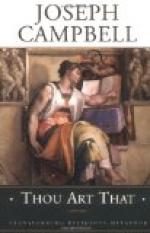|
This section contains 458 words (approx. 2 pages at 400 words per page) |

|
Thou Art That Summary & Study Guide Description
Thou Art That Summary & Study Guide includes comprehensive information and analysis to help you understand the book. This study guide contains the following sections:
This detailed literature summary also contains Topics for Discussion and a Free Quiz on Thou Art That by Joseph Campbell.
Thou Art That by Joseph Campbell looks at the Judeo-Christian tradition in light of world mythology, showing how an over-emphasis on history and exclusivity rob the stories and the religions of spiritual power and relevancy.
Thou Art That opens with Joseph Campbell debating with a know-it-all radio personality the meaning of "myth." Myth means not lie, Campbell says, but metaphor. Many times he reiterates this, because the false meaning is deeply set in the popular mind. Mythology aligns individuals' consciousness to the mystery of the universe, helps societies perceive the mystery of time and space, validates and supports moral order in society, and carries individuals through life's stages and crises. Mystical traditions split in Iran, with Western forms (Zoroastrianism, Judaism, Christianity, and Islam) insisting that God and the world are not the same, seeking to submit human judgment to God's power, and requiring intermediaries. In the East, the "masks of God" are gone, because no categories can be attributed to a "Ground of Being."
When Yahweh declares himself "exclusive God," his followers become closed to universal spirituality, but when the story of the Jews is told, after the Babylonian exile, the writers edit the great Middle Eastern mythologies of creation, garden, exile, and flood, and apply to their heroes the myths at large in the human. The Exodus from Egypt forms a people united by a sense of being uniquely chosen,which becomes an ethnic religion.
From this legacy, emerges Christianity, like the older Buddhism and younger Islam, a "world religion" based on creeds. Looking back on Jesus' life in light of the Crucifixion and Resurrection, disciples attach the myths commonly associated with great kings and teachers. The Virgin Birth, the cave, visitations to the infant, the flight into Egypt, the child Jesus teaching in Jerusalem, the characteristics of the Messiah, and Jesus miracles all have parallels in other religious figures that cannot be incidental. The Last Supper and Judas' role in the betrayal, the Crucifixion, and end of the world all have mythological ties. Why Jesus has to die on the Cross has several classical answers, which focus on the historicity of Adam and Eve's fall and Jesus' particular crucifixion, overlooking the spiritual lesson that God comes down to humankind and takes humankind to himself freely and joyfully, with no negative psychological colorings.
That "the Kingdom of God is within you" is the perspective that Christians must adopt in light of the Space Age. There is no "up there" to which to ascend or be assumed. The Kingdom, as Jesus says in a Gnostic gospel text, comes unexpected and is everywhere. All religions should open up to the universality of the human spiritual experience rather than continuing to fight over dubious historical points.
Read more from the Study Guide
|
This section contains 458 words (approx. 2 pages at 400 words per page) |

|



